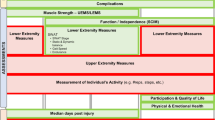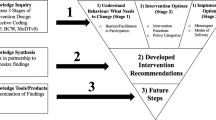Abstract
Community engagement is an important method of knowledge translation in spinal cord injury (SCI) research where researchers collaborate with people with lived experience, care partners, and other research users to improve the quality of research. This perspective article aims to promote community engagement in SCI research by describing useful resources for its implementation and providing an example project using the North American Spinal Cord Injury Consortium (NASCIC) process for such partnerships. Researchers from the Jefferson College of Rehabilitation Sciences’ (JCRS) Center for Outcomes and Measurement engaged NASCIC to create an advisory committee composed of four people living with SCI to make recommendations for the methods of a large-scale study to develop a clinical outcome assessment. The advisory committee made usable recommendations for enhancing recruitment methods and reducing burden and barriers to participation. The successful partnership between NASCIC and JCRS shows the feasibility and value of SCI community engagement in research.
This is a preview of subscription content, access via your institution
Access options
Subscribe to this journal
Receive 12 print issues and online access
$259.00 per year
only $21.58 per issue
Buy this article
- Purchase on Springer Link
- Instant access to full article PDF
Prices may be subject to local taxes which are calculated during checkout

Similar content being viewed by others
Data availability
Structured conversation guides from the advisory committee meetings are available in Supplementary File 1 and data from the modified Stakeholder-Centric Engagement Evaluation are available upon request to the corresponding author.
References
Carman KL, Dardess P, Maurer M, Sofaer S, Adams K, Bechtel C, et al. Patient and family engagement: a framework for understanding the elements and developing interventions and policies. Health Aff. 2013;32:223–31.
Meissner P, Cottler LB, Eder MM, Michener JL. Engagement science: the core of dissemination, implementation, and translational research science. J Clin Transl Sci 2020;4:216–8.
Key KD, Furr-Holden D, Lewis EY, Cunningham R, Zimmerman MA, Johnson-Lawrence V, et al. The continuum of community engagement in research: a roadmap for understanding and assessing progress. Prog Community Health Partnersh. 2019;13:427–34.
Center for Drug Evaluation and Research; Center for Biologics Evaluation and Research (US). Patient-focused drug development: collecting comprehensive and representative input—guidance for industry, food and drug administration staff, and other stakeholders. Silver Spring (MD): Center for Drug Evaluation and Research (US); 2020, p. 34. Report No. FDA-2018-D-1893.
Andrews D, Fong G, Li L, Mathews M, Russell D, Angus D, et al. Guide to knowledge translation planning at CIHR: integrated and end-of-grant approaches. Canadian Institutes of Health Research; 2012. p. 34. https://cihr-irsc.gc.ca/e/45321.html.
Department of Defense Congressionally Directed Medical Research Programs (US). Spinal cord injury. 2022. https://cdmrp.health.mil/scirp/default.
Patient-Centered Outcomes Research Institute. The patient-centered outcomes research institute strategic plan: Generating evidence to achieve more efficient, effective, and equitable health care and improve health for all. Washington (DC): Patient-Centered Outcomes Research Institute; 10 p. (2022).
Morse LR, Field-Fote EC, Contreras-Vidal J, Noble-Haeusslein LJ, Rodreick M, Shields RK, et al. Meeting proceedings for SCI 2020: launching a decade of disruption in spinal cord injury research. J Neurotrauma. 2021;38:1251–66.
Advisory Committee to the Director Working Group on Diversity Subgroup on Individuals with Disabilities. National Institutes of Health. 2022. https://acd.od.nih.gov/documents/presentations/12092022_WGD_Disabilities_Subgroup_Report.pdf.
North American Spinal Cord Injury Consortium. North American spinal cord injury consortium charter 4.0. 4th ed. North American Spinal Cord Injury Consortium; 2021, p. 11. https://nasciconsortium.org/about-us/charter/.
Gainforth HL, Hoekstra F, McKay R, McBride CB, Sweet SN, Martin Ginis KA, et al. Integrated knowledge translation guiding principles for conducting and disseminating spinal cord injury research in partnership. Arch Phys Med Rehabil. 2021;102:656–63.
Martínez J, Piersol CV, Holloway S, Terhorst L, Leland NE. Evaluating stakeholder engagement: stakeholder-centric instrumentation process (SCIP). West J Nurs Res. 2021;43:949–61.
Biller OM, Biundo J, Mitchell ES-L, Ofori EB, Richardson B, Kim RY, et al. Engaging stakeholders as advisors on the design of a large-scale calibration study of the Spinal Cord Injury Movement Index (SCI-MI) item pools. Poster session presented at: The 61st International Spinal Cord Society Annual Scientific Meeting; 2022; 15-18: Vancouver, Canada.
North American Spinal Cord Injury Consortium. NASCIC research advocacy course. (2022). https://nasciconsortium.org/courses/nascic-community-engagement-program-cep/ (2022).
Acknowledgements
We would like to acknowledge that in this paper we use the term “community engagement” and not everyone involved in SCI research identifies with this term. Another similar term that is widely used is “consumer engagement.” However, the authors of this paper agreed upon and felt comfortable with the term “community engagement” for this specific manuscript. We thank Jenny Martínez for permission to use and adapt the Stakeholder-Centric Engagement Evaluation in this project, and Jennifer French for assisting with developing our proposal to NASCIC. We would also like to thank Daniel Graves, Lydia Navarro-Walker, Tina DeAngelis, and Namrata Grampurohit for providing feedback on the conversation guides for the advisory committee. Ernest B. Ofori served as a member of the advisory committee, and we acknowledge his contributions to the project. The JCRS COM provided support for the NASCIC advisory board, and the Craig H. Neilsen Foundation (grant #597640, PI: Mulcahey) provided grant support for the item pool development of the COA described in the paper. This project was completed in partial fulfillment for the Doctoral Degree in Occupational Therapy at Thomas Jefferson University, Philadelphia, Pennsylvania (OMB).
Funding
The Jefferson College of Rehabilitation Sciences’ Center for Outcomes and Measurement provided support for the NASCIC advisory board.
Author information
Authors and Affiliations
Contributions
OMB: conceptualized project; wrote and revised proposal to NASCIC; organized and conducted all advisory meetings; summarized recommendations and suggestions from all advisory committee meetings; led development of manuscript. JB: served on advisory committee, led development and writing of manuscript. EM: served on advisory committee, assisted with writing manuscript. BR: served on advisory committee, assisted with writing manuscript. IB: coordinated advisory meetings, assisted with writing manuscript. RYK: assisted with project conceptualization; debriefed on recommendations and suggestions from advisory meetings; reviewed and provided feedback on manuscript. NG: assisted with project conceptualization; debriefed on recommendations and suggestions from advisory meetings; reviewed and provided feedback on manuscript. MJM: conceptualized project; assisted with writing and revising proposal to NASCIC; assisted with organization of advisory committee meetings; debriefed on recommendations and suggestions from advisory meetings; provided substantial feedback on drafts of manuscript.
Corresponding author
Ethics declarations
Competing interests
The authors declare no competing interests.
Additional information
Publisher’s note Springer Nature remains neutral with regard to jurisdictional claims in published maps and institutional affiliations.
Supplementary information
Rights and permissions
Springer Nature or its licensor (e.g. a society or other partner) holds exclusive rights to this article under a publishing agreement with the author(s) or other rightsholder(s); author self-archiving of the accepted manuscript version of this article is solely governed by the terms of such publishing agreement and applicable law.
About this article
Cite this article
Biller, O.M., Biundo, J., Mitchell, E.SL. et al. Promoting community engagement in spinal cord injury research: a case example. Spinal Cord 61, 632–635 (2023). https://doi.org/10.1038/s41393-023-00926-x
Received:
Revised:
Accepted:
Published:
Issue Date:
DOI: https://doi.org/10.1038/s41393-023-00926-x



